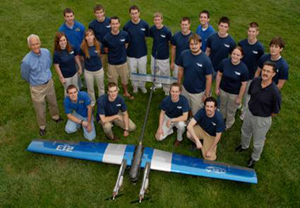 The ultimate goal of the Missouri Space Grant Consortium is to inspire, engage and educate students through the support of multidisciplinary teams. A group of 30 undergraduate and graduate students from various fields of studies works together at the University of Missouri-Rolla to become the Advanced Aero Vehicle Group (AAVG). The Advanced Aero Vehicle Group completed three projects this year, a boosted dart, and an Open and Micro class entry into the Society of Automotive Engineers (SAE) Aero Design Competition. Each of these three challenging projects pushed the abilities of the team members in different ways as they competed against students from around the country. The ultimate goal of the Missouri Space Grant Consortium is to inspire, engage and educate students through the support of multidisciplinary teams. A group of 30 undergraduate and graduate students from various fields of studies works together at the University of Missouri-Rolla to become the Advanced Aero Vehicle Group (AAVG). The Advanced Aero Vehicle Group completed three projects this year, a boosted dart, and an Open and Micro class entry into the Society of Automotive Engineers (SAE) Aero Design Competition. Each of these three challenging projects pushed the abilities of the team members in different ways as they competed against students from around the country.
The Advanced Aero Vehicle Group (AAVG) at the University of Missouri-Rolla recently developed and participated in a rocket competition with Iowa State University. The goals of the competition were to design, successfully fly, and recover a boosted dart rocket. The design and construction of the rocket began with the start of the school year. The team designed a rocket with minimum fin area for stable flight and optimized the weight to reach the target altitude of 23000 ft using computer simulations. The motor selected, the M1939, has a total impulse of 10240 N-sec with a 6 sec burn time. Using this motor, the maximum flight velocity was predicted to be 1300 mph. The finished rocket stood at 11 ft tall and had a booster diameter or 4.5 in and a dart diameter of 1.5 in. The weight of the vehicle without the motor was 15 lbs
The flight was straight and fast with the separation of the dart as planned shortly after motor burnout. However, high winds above 10000ft made the dart trajectory stray from vertical resulting in a less then the predicted max altitude. Both sections of the rocket were successfully recovered under parachute and were safely recovered downwind of the launch site. Onboard electronics reported a maximum dart altitude just shy of 19000 ft. While disappointed in the altitude results, the team was very satisfied with the flight of the rocket. Iowa State was not able to fly their rocket due to technical difficulties, but have issued a challenge for a rematch this spring. AAVG also hopes to expand this competition to other schools next year.
The micro class team was tasked with building the aircraft with the highest payload fraction, the weight of the payload divided by the empty weight of the aircraft. The scoring formula used in the competition also gave more points for aircraft with low empty weights, maximized for an aircraft with an empty weight of zero pounds. A micro class aircraft was successfully completed; however, the high winds at the competition proved to be too much for the lightweight design. Not all was lost and the micro class team achieved a 4th place finish in the design presentation.
The Open Class competition requires teams to design, build, and fly a radio control aircraft that can takeoff with the greatest amount of payload in less than 100 ft with a maximum weight of 55 lbs. The Open Class aircraft has a 12 ft wing span, an empty weight of 12 pounds, and two 0.60L Jett Engineering Engines. The Open Class aircraft was also designed to gain additional bonus points by completing a flight with zero payload and stopping within the landing zone. The team was successful in completing a zero payload flight. During the aircraft’s second flight at the maximum takeoff weight of 55 lbs the aircraft suffered a catastrophic structural failure. Even without successfully completing the final maximum weight flight the team ranked 4th overall. See the group’s website at http://web.umr.edu/~aavg for more information, competition photos and video.
~KYLE A. ZIMMER, UNIVERSITY OF MISSOURI-ROLLA
|







